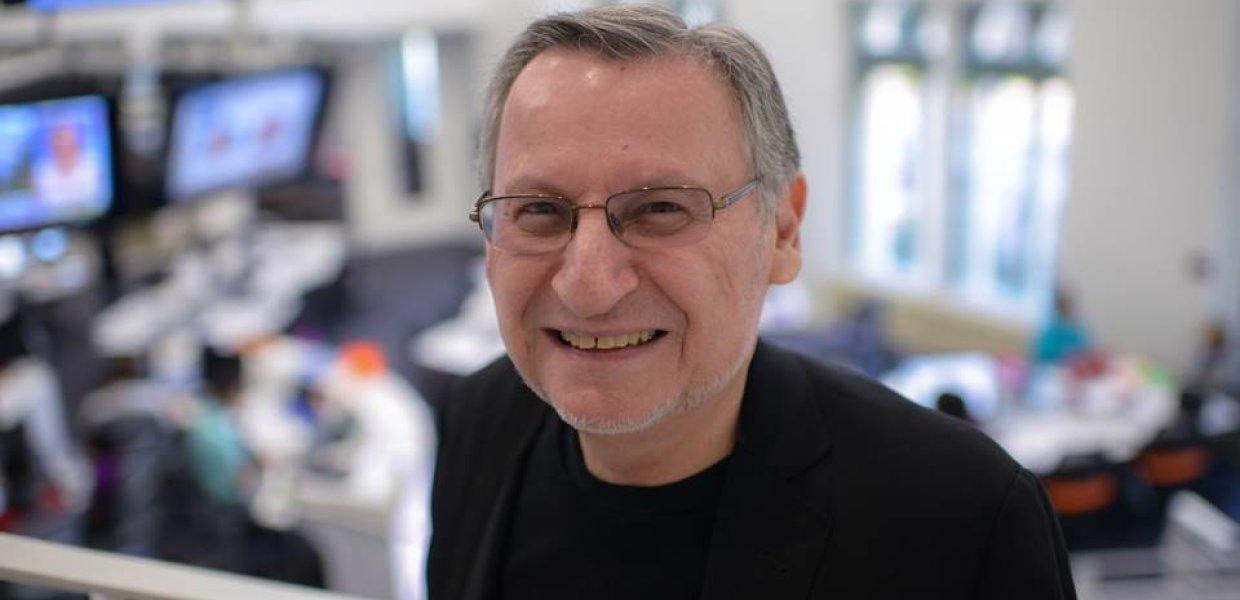Inside the classrooms at USC Annenberg, students are the ones typically tasked with answering the hard hitting questions. "Five Minutes with..." turns the table on faculty members to ask them the questions we've been itching to know the answers to.
Professor Joe Saltzman has been a principal figure at USC Annenberg for nearly 50 years. He is an award-winning journalist, a documentarian and the author of several books. He is also known for his pioneering research into the portrayal of journalists in popular culture.
On Aug. 5, Saltzman’s storied career is being honored by the Association for Education in Journalism and Mass Communication (AEJMC) at their annual conference in San Francisco. A panel of Saltzman’s friends and colleagues will reflect on the profound impact he’s had as a teacher, mentor, journalist and scholar.
What does it mean to you to have your career recognized by AEJMC?
It means a great deal to me to be recognized by my colleagues. That has always been the way I have measured my professional and academic career. Three awards have had special meaning to me. When I was a professional broadcast journalist, the top award you could win was the Columbia University-duPont Award for broadcast journalism and when my documentary on breast cancer, “Why Me?,” won it I felt that I had finally arrived at the pinnacle of my profession. The AEJMC-Scripps Howard Foundation’s Journalism & Mass Communication Teacher of the Year Award is the highest award you can win as a journalism professor and when I won that in 2010, I likewise felt that I had made my mark in journalism education. And in 2005, I was awarded the Journalism Alumni Award from the Columbia University Graduate School of Journalism, an award I coveted because of the prestige of the school’s alumni.
When you work as a professional journalist or a teacher, the last thing on your mind is winning awards. You just try to be the best journalist or faculty member you can be. The awards offer a bit of proof that you achieved some of your goals. I am a very lucky person to have been given the chance to be considered for these awards and the AEJMC recognition panel is special because it means my colleagues think I have done a good job.
What makes you proud to have been a professor at USC Annenberg for more than 50 years?
I started as an adjunct faculty member in 1967 teaching newswriting while working at CBS. I ended up teaching as many as six sections a year and realized I really enjoyed teaching. In 1974, I was asked to create the broadcasting sequence in the USC School of Journalism, then a part of the College of Letters, Arts and Sciences. I created the entire curriculum based on my experiences as a broadcast journalist in a very young industry and then hired the best broadcast journalists in Los Angeles to teach the classes. I also taught each class once to make sure the syllabus worked. We were an instant success story and in two years won accreditation from AEJMC and became one of the best broadcast journalism sequences in the country. I am very proud of the people I recruited to become part of the USC faculty, especially the professionals who came in once a week to share their knowledge with our students. For more than three decades, I did all of the broadcast and print curricula, hired all of the part-time faculty, and created one class after another. It was a heady time to be at USC and I enjoyed every minute of it.
I also find it hard to realize that I’ve been on the USC campus since 1957 when I came here as a student. USC is intimately involved in my professional and personal life – I met my wife, Barbara, at USC in 1958. We both were editors of the Daily Trojan and Phi Beta Kappas, and we’ve been married for 53 years. My daughter-in-law Jennifer met my son Michael at a USC party (she was getting a master’s degree in broadcast journalism). Faculty and staff members and former students are among my closest friends. It’s been a wonderful place to be for more than half a century. I have enjoyed being associate director and acting director of the School, associate dean of USC Annenberg, head of both the print and broadcast sequences for more than 20 years, and now just a happy faculty member.
You earned your bachelor’s degree in journalism degree from USC. If you were attending USC Annenberg today, which class would you be most interested in taking and why?
I have such respect for so many of my colleagues who teach at USC that naming them would mean I would leave someone I love out of the mix. But the one class I would love to have taken was the one taught for decades by the late Professor Emeritus Jack Langguth, whose knowledge of history, journalism, writing and life in general, made his class the one every student wanted to take while Langguth was at USC.
What has been your favorite lesson or most memorable class you’ve taught at USC Annenberg and why?
For more than three decades I taught Journalism 405 (Non-Fiction Television) and Journalism 521 (Pre-Production of Non-Fiction Television) and enjoyed every class even though the workload was enormous and the class very demanding. In one alumni poll, both classes were voted among the toughest taken in the School of Journalism and that meant more to me than high student evaluations. Almost once a week, a former student writes me an email or letter, or calls to tell me he or she is still using material learned in those classes 20 or 30 years ago. Julie Chen amazed me by quoting things I had said in class – and I know she was quoting me accurately because I continue to say those same things today. I stopped teaching the classes to move on to other courses mostly because Dan Birman, a superb documentarian and a former student, took over both classes and I knew the students would be in good hands.
My newest classes – Journalism 375 (Journalism Ethics Goes to the Movies) and Journalism 599 (Journalism Ethics Goes to the Movies Graduate Seminar) – are among the most enjoyable classes I have taught at USC Annenberg. The discussions on all kinds of ethical issues in one three-hour session make me happy to be in the classroom where shared experiences reveal all the nuances of an ethical question.
For more than 20 years, you’ve been researching representations of journalists in popular culture. What drew you to this topic? What’s next in your research?
In 1989, my son David developed Hodgkin’s disease as a senior at Yale. A year later, 11 days before his 23rd birthday, David died. It was an overwhelming tragedy and the way I handled it was to bury myself in the stacks at Doheny Library researching a subject that caught my interest – the image of the journalist in film. There had been several books on the subject but not much else written on the image of the journalist in all aspects of popular culture, a subject that also fascinated me. So I spent hours looking into the subject starting with the 20th century and going back to the 19th, 18th, 17th, 16th centuries, back to Roman and Greek times, back to the beginnings of recorded history to analyze the image of those people who performed the function of journalists. Many academics thought I was wasting my time because the image of the journalist in popular culture was not an academic field. My professional colleagues thought I was wasting my time because they thought I should be doing real journalism.
After five years, I came out of my depression to discover that I had more than 10,000 pages in my computer on the subject. And the Image of the Journalist in Popular Culture (IJPC) was born. Thanks to former Dean Geoffrey Cowan and Director Marty Kaplan of the Norman Lear Center, the IJPC became a project of the Norman Lear Center, giving the IJPC instant credibility. I recruited scholars and professionals from around the world who had an interest in the subject, created the IJPC Web site and the IJPC Database, which are now the definitive world-wide resources on the subject, and was one of the founding editors of a peer review The IJPC Journal. The IJPC is now recognized worldwide as an academic discipline. The IJPC Web site collects thousands of articles and references from around the world. The IJPC Database has more than 87,000 entries documenting the image of the journalist in film, television, radio, fiction, commercials, cartoons, comic books, and every other aspect of popular culture.
We’ve very proud of our newest venture – The Heroes and Scoundrels Journalist in Popular Culture Project, which includes our new book, “Heroes and Scoundrels: The Image of the Journalist in Popular Culture” by Matthew C. Ehrlich and Joe Saltzman (University of Illinois Press, 2015). The project also includes the Heroes and Scoundrels Web Site (included in www.ijpc.org), which features continuous updates; a 40-hour video companion to the book, which includes excerpts from more than 350 movies, television and radio programs, Broadway plays and video games, and a ready-to-teach class syllabus.
Our next project will be a major study never before attempted: The Image of the Journalist in Movies and Television, 1914-2014. It will compliment previous innovative studies of the Image of the Washington Journalist and the Image of the Public Relations Practitioner in Movies and Television. More than 6,500 films are being coded as to type, genre, decade, gender, ethnicity, media category, job title, and evaluation from very positive to very negative. The analysis has been underway for two years and is scheduled for completion and publication in 2017.





